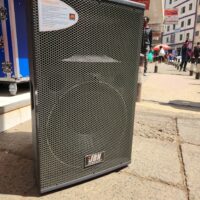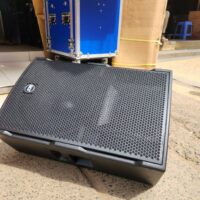Church Speakers
Let delve into church speakers and the various options available
Mid-Range Church Speakers
Role and Importance: Mid-range speakers are crucial components in a church’s sound system. They are responsible for delivering clear and consistent audio, making sure that the congregation can hear and understand the main message without any difficulty. These speakers handle the essential frequencies that encompass most vocal ranges and many instruments.
Specifications:
- Size and Brands: A common size for mid-range speakers is 15 inches. Well-known brands such as Electro-Voice (EV) and RCF are reputable for their quality and reliability in this category.
- Usage: Depending on the size of your church, the number of mid-range speakers required can vary. A general rule of thumb is that one pair of speakers can adequately cover around 150 people. For larger congregations, you will need more speakers to ensure even coverage and clarity throughout the space.
Additional Features:
- Monitor Capabilities: Some mid-range speakers, like the RCF 15-inch models, can double as monitor speakers. This versatility allows them to be used both for the main congregation and as stage monitors for the preacher or musicians.
Church Monitor Speakers
Role and Importance: Monitor speakers are positioned at the front of the stage, facing the preacher or performers. Their primary function is to provide real-time audio feedback to the speaker or musician, allowing them to hear themselves and adjust their volume, pitch, and tone accordingly.
Specifications:
- Size and Brands: Monitor speakers typically come in 12-inch or 15-inch sizes. Both sizes offer clear sound, with the choice depending on personal preference and specific needs. Brands such as EV and RCF are noted for their high-quality monitor speakers.
- Positioning: These speakers are crucial for ensuring that the preacher or performer has an accurate sense of how they sound to the audience, which can significantly enhance the quality of the delivery.
Church Full Range Speakers
Role and Importance: Full range speakers are designed to handle a wider spectrum of sound frequencies. They are especially useful in larger settings, such as outdoor crusades or large church gatherings, where a powerful and comprehensive sound system is necessary.
Specifications:
- Components: These speakers usually incorporate two drivers and a tweeter. The drivers typically include a mid-range speaker and a bass speaker, although the exact configuration can vary based on the model.
- Usage: Full range speakers are capable of producing substantial sound output, making them ideal for large venues. They ensure that both the spoken word and music reach the entire audience with clarity and impact.
Benefits:
- Versatility: Full range speakers are well-suited for various applications, from indoor services to large outdoor events. Their ability to cover a broad frequency range means they can deliver everything from clear vocals to deep bass tones.
Summary
- Mid-Range Speakers:
- Backbone of the sound system.
- 15-inch models from EV and RCF are recommended.
- One pair can cover approximately 150 people.
- Can also be used as monitor speakers.
- Monitor Speakers:
- Positioned to face the preacher or performers.
- Available in 12-inch or 15-inch sizes.
- Provide real-time feedback to ensure accurate delivery.
- Full Range Speakers:
- Ideal for large gatherings and outdoor events.
- Contain mid-range and bass speakers plus a tweeter.
- Capable of producing powerful, full-spectrum sound.
Customizing Your Church Speakers
Overview: Customization offers a unique opportunity to tailor your speakers to your specific needs and preferences, ensuring optimal sound quality and performance at a more affordable cost.
Process:
- Choose a Pre-Made Cabinet: Start by selecting a pre-made cabinet. These come in various sizes, such as 12-inch, 15-inch, and 18-inch, allowing you to pick the one that best suits your space and requirements.
- Match the Speakers: Once you have your cabinet, you can match it with the speakers that provide the best sound for your needs. This step involves selecting the drivers (speakers) that will be installed in the cabinet.
- Internal Components: In addition to the speakers, it’s important to choose high-quality internal crossovers and tweeters. Crossovers ensure that the audio signal is divided correctly between the different drivers, while tweeters handle the high-frequency sounds.
- Testing and Final Adjustments: After assembling your customized speaker, it will be tested to ensure it meets your expectations. This step is crucial to verify the sound quality and make any necessary adjustments.
- Finishing Touches: For a professional and durable finish, add metal handles to the cabinet. This not only enhances the appearance but also makes the speakers easier to transport and handle.
Advantages:
- Affordability: Customizing your speakers can be more cost-effective than purchasing brand-name models.
- Personalization: You get a hands-on feel for what you are getting, ensuring the final product meets your specific needs.
- Quality Assurance: Testing ensures the speakers perform to your expectations before finalizing the setup.
By understanding the roles and specifications of each type of speaker and the benefits of customization, you can ensure that your church’s sound system is well-equipped to deliver clear and impactful audio to all attendees, whether in a small chapel or a large outdoor crusade.






